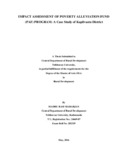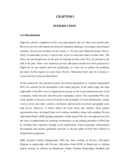Please use this identifier to cite or link to this item:
https://elibrary.tucl.edu.np/handle/123456789/2339| Title: | Impact Assessment of Poverty Alleviation Fund (Paf) Program: A Case Study of Kapilvastu District |
| Authors: | Maharjan, Madhu Ram |
| Keywords: | Poverty alleviation;Kapilvastu;Social Policy;Poverty |
| Issue Date: | May-2016 |
| Publisher: | Central Department of Rural Development Tribhuvan University, Kathmandu |
| Abstract: | Poverty is one of the major factors that bring obstacles in any kind of growth and development in any part of the world. The problem of poverty is complex in our country. One fourth of Nepal’s population is under the poverty line which is an alarming issue to national development. They are living with quite miserable conditions in terms of basic needs such as food, cloth, shelter that require just for the survival of human beings. Poverty is a relationship between the essential needs of the people for survival and physical efficiently and their ability of satisfying them. Those who can not satisfying basic needs such as food, clothing and shelter are called poor. Poverty reduction has been one of the most prioritized agenda of the nation since poverty was officially noticed in 1976. Even though, poverty laid emphasis in most of the five year periodic plans such as first, third, fifth and ninth five year plan categorically to the poverty reduction program, while the very tenth plan was developed as the poverty reduction strategy paper (PRSP). In view with considerable figures of poor population in the country, the Tenth Plan (2002-2007) has made its single objective to alleviate poverty. To meet the national objective of poverty alleviation, there is a need of appropriate modalities and approaches to reduce poverty in downtrodden societies of Nepal. There are so many poverty alleviation models adopted in Nepal but not significantly decrease the level of poverty. But attempts to reduce poverty by formulating the clear strategic interventions too did not succeed as the government failed to reach out the extreme poor. Realizing these lacking, the government had set up the PAF program for involving the extreme poor categorically in most inclusive manner. The central bureau of statistics revealed that there is widespread prevalence of poverty among Dalits, Janjatis, Muslims and Women in the country. Hence PAF has taken them as target groups and has implemented poverty reduction program for them. Not, just in rural areas, poverty has risen in urban areas as well in recent year. Amid growing urbanization and lack of employment opportunities, many people have fallen in vicious cycle of poverty. Likewise, poverty is rampant among and Brahmin communities as well. In this context, this study focuses on the existing modality and approaches to reduce the poor in the community and how the resource poor and disadvantaged section of the society were empowered and the strategy of social policies that really helped on poverty reduction and alleviation efforts in downtrodden community |
| URI: | http://elibrary.tucl.edu.np/handle/123456789/2339 |
| Appears in Collections: | Rural Development |
Files in This Item:
| File | Description | Size | Format | |
|---|---|---|---|---|
| cover.pdf | 142.75 kB | Adobe PDF |  View/Open | |
| Thesis.pdf | 631.88 kB | Adobe PDF |  View/Open |
Items in DSpace are protected by copyright, with all rights reserved, unless otherwise indicated.
